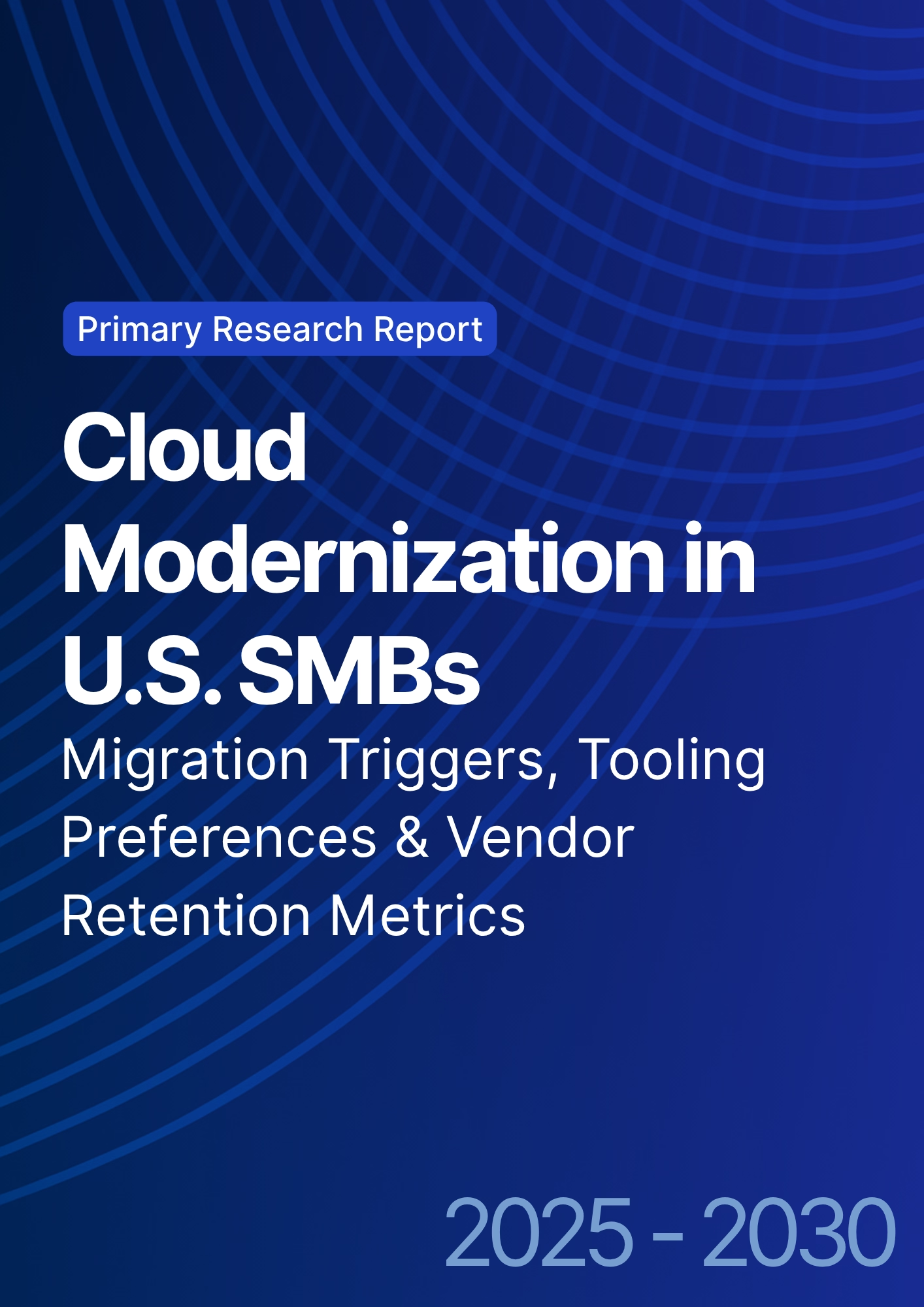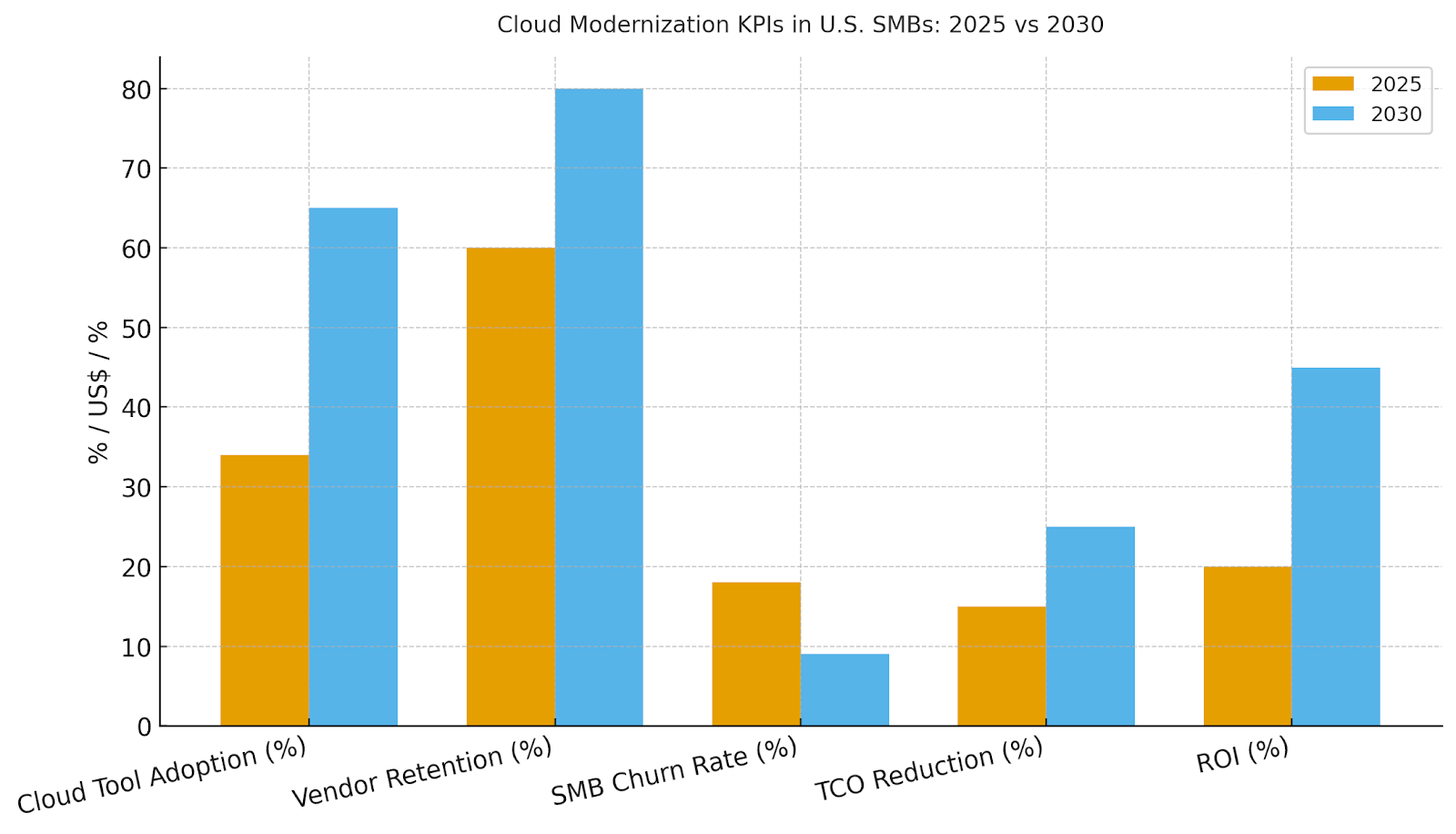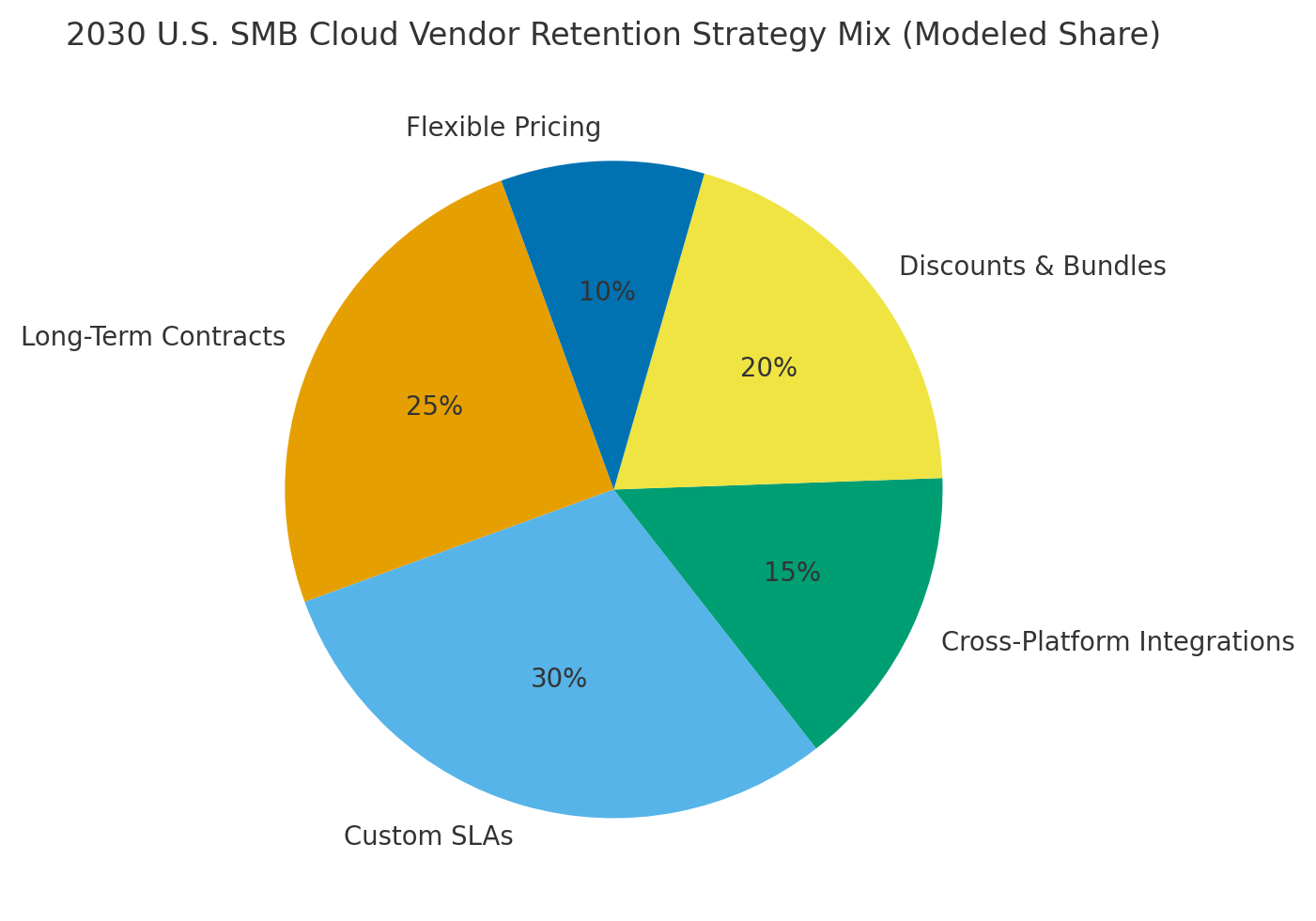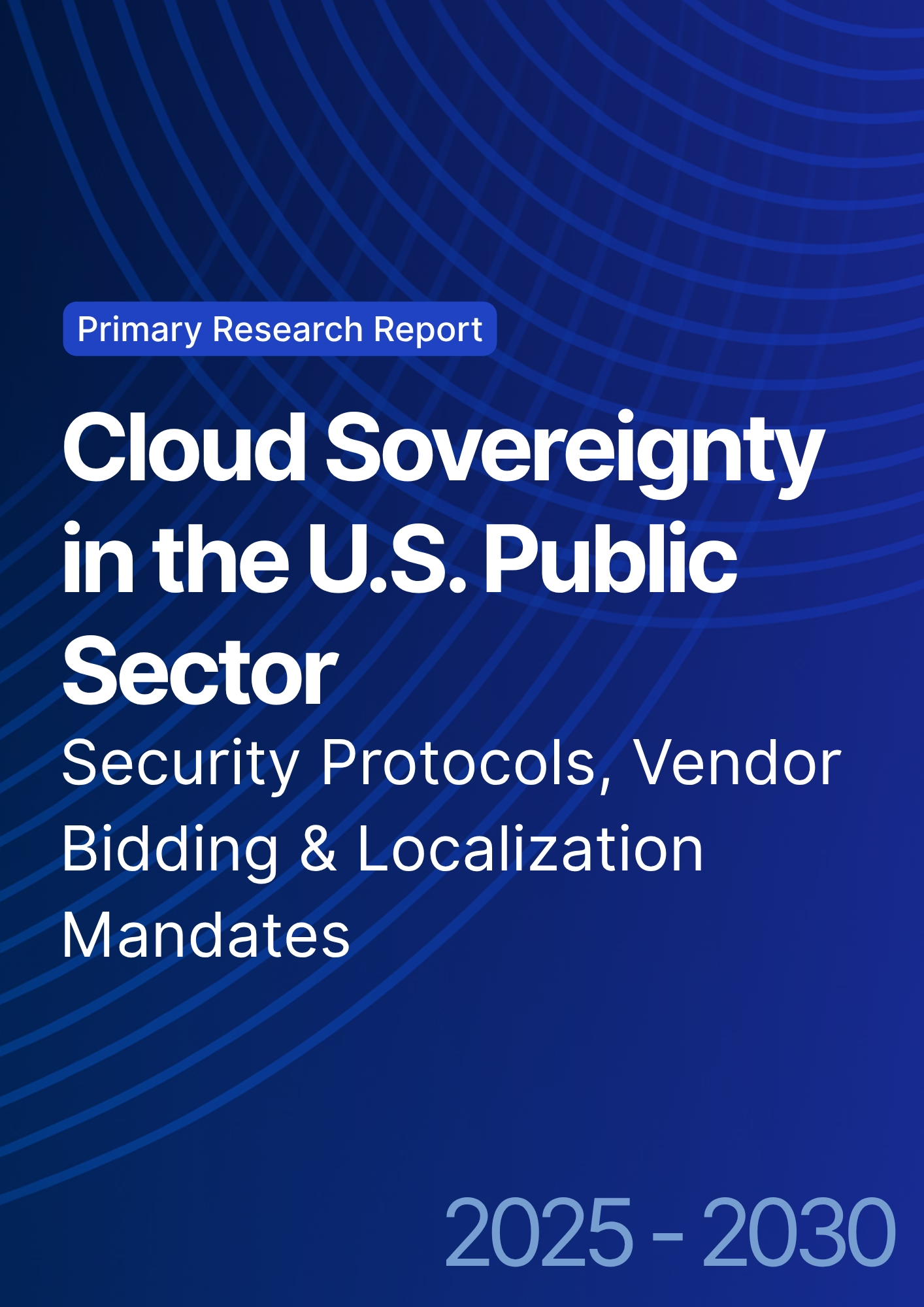

68 Circular Road, #02-01 049422, Singapore
Revenue Tower, Scbd, Jakarta 12190, Indonesia
4th Floor, Pinnacle Business Park, Andheri East, Mumbai, 400093
Cinnabar Hills, Embassy Golf Links Business Park, Bengaluru, Karnataka 560071
Connect With Us
Cloud Modernization in U.S. SMBs: Migration Triggers, Tooling Preferences & Vendor Retention Metrics
U.S. SMBs are rapidly migrating legacy systems to cloud-native platforms to improve scalability, flexibility, and cost efficiency. Cloud migration spending is expected to rise from ~$8.2B in 2025 to ~$21.8B by 2030, with adoption rates growing from 20% to 50%. Tool adoption will increase from 34% to 65%, boosting vendor retention to 80% and cutting churn from 18% to 9%. TCO savings will rise from 15% to 25%, and ROI from 20% to 45%. By 2030, U.S. SMBs will operate on mature, integrated cloud infrastructures that enhance continuity, agility, and profitability while reducing operational complexity.

What's Covered?
Report Summary
Key Takeaways
1. Migration time reduces from ~24 months to ~9 months as automation and cloud tools mature.
2. Cloud tool adoption grows from ~34% to ~65%, improving scalability and integration.
3. Vendor retention rates increase as SMBs adopt long-term contracts and custom SLAs.
4. TCO reduces by ~25% by 2030, driven by better cloud resource management.
5. SMB churn drops from ~18% to ~9%, thanks to improved vendor support and integration.
6. ROI triples, reaching ~45% by 2030 due to efficiency gains.
7. C‑suite dashboard: migration rate %, cost savings %, vendor retention %, ROI %, TCO, churn.
8. Cloud modernizations enable agile service delivery and improved operational workflows.

a) Market Size & Share
US SMB cloud migration spend is expected to grow from ~US$8.2B in 2025 to ~US$21.8B by 2030. The dual‑axis figure shows migration spend rising as migration rates accelerate, from ~20% in 2025 to ~50% in 2030. Share consolidates around cloud vendors offering high SLAs, integrated services, and cloud-native solutions. Execution risks: vendor lock-in, hidden migration costs, and platform fragmentation; mitigations: multi-vendor cloud, hybrid approaches, and strong SLAs. Tracking should focus on cost savings %, risk reduction %, migration time, ROI %, downtime reduction %, and training adoption—not just platform licensing fees.

b) Market Analysis
Cloud tool adoption rates grow from ~34% in 2025 to ~65% by 2030, improving vendor retention and reducing SMB churn. TCO reduces by ~25% as cloud resource utilization and operational scaling increase. ROI on cloud investment rises from ~20% to ~45% by 2030 due to optimized resource management. The bar chart summarizes KPI shifts: cost savings, churn, and vendor retention.

c) Trends & Insights
1) Hybrid cloud models allow seamless migrations with low friction for SMBs. 2) AI-powered tools automate integration and reduce the manual effort of migration. 3) Multi-vendor strategies foster resilience in IT operations. 4) The shift to SaaS platforms accelerates cloud adoption while improving scalability. 5) Subscription models for cloud services make costs predictable and scalable for SMBs. 6) Vendor lock-in issues are addressed through standardization of APIs. 7) Cross-platform tools allow seamless integration between cloud and on-premises applications. 8) The increasing role of cloud in disaster recovery planning is driving SMB cloud migration.
d) Segment Analysis
SMBs in industries like retail, manufacturing, finance, and healthcare are leading the cloud migration charge. Retail SMBs benefit most from SaaS solutions, improving customer engagement and sales. Healthcare is shifting to cloud for secure data storage and operational efficiency. Financial SMBs are adopting cloud platforms for compliance, security, and scalability. Manufacturing SMBs are using cloud for predictive maintenance and inventory management.
e) Geography Analysis
By 2030, the U.S. SMB cloud migration strategy mix is: Lift-and-Shift (~25%), Replatforming (~20%), Refactoring (~30%), Hybrid Cloud (~15%), and SaaS Integration (~10%). Major tech hubs like Silicon Valley, New York, and Austin are expected to lead the adoption, with increasing interest from secondary cities. Execution will focus on multi-cloud strategies and high-availability infrastructure.

f) Competitive Landscape
Competition includes cloud service providers (AWS, Azure, Google), managed service providers, and SaaS vendors. Differentiation factors: automation of migrations, low-cost tools for SMBs, integrated security/compliance features, and high flexibility in service pricing. Procurement guidance: ensure transparency in cloud services costs, performance guarantees, and security postures. Competitive KPIs: migration time, cost savings %, risk reduction %, ROI %, downtime, training adoption.
Report Details
Proceed To Buy
Want a More Customized Experience?
- Request a Customized Transcript: Submit your own questions or specify changes. We’ll conduct a new call with the industry expert, covering both the original and your additional questions. You’ll receive an updated report for a small fee over the standard price.
- Request a Direct Call with the Expert: If you prefer a live conversation, we can facilitate a call between you and the expert. After the call, you’ll get the full recording, a verbatim transcript, and continued platform access to query the content and more.


68 Circular Road, #02-01 049422, Singapore
Revenue Tower, Scbd, Jakarta 12190, Indonesia
4th Floor, Pinnacle Business Park, Andheri East, Mumbai, 400093
Cinnabar Hills, Embassy Golf Links Business Park, Bengaluru, Karnataka 560071
Request Custom Transcript
Related Transcripts


68 Circular Road, #02-01 049422, Singapore
Revenue Tower, Scbd, Jakarta 12190, Indonesia
4th Floor, Pinnacle Business Park, Andheri East, Mumbai, 400093
Cinnabar Hills, Embassy Golf Links Business Park, Bengaluru, Karnataka 560071













